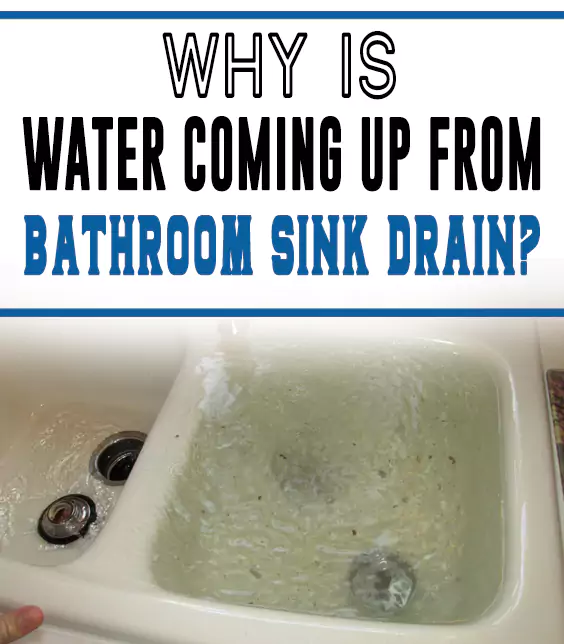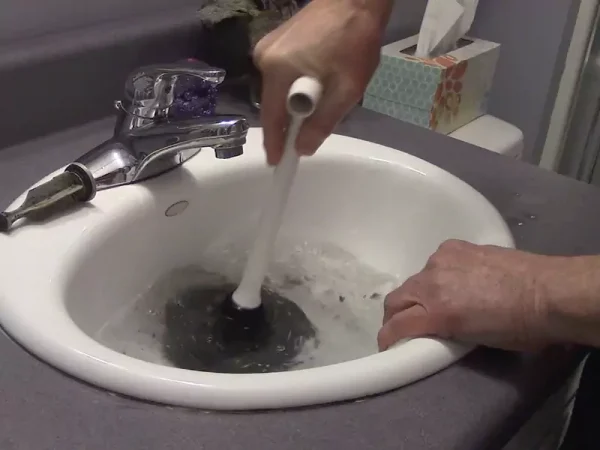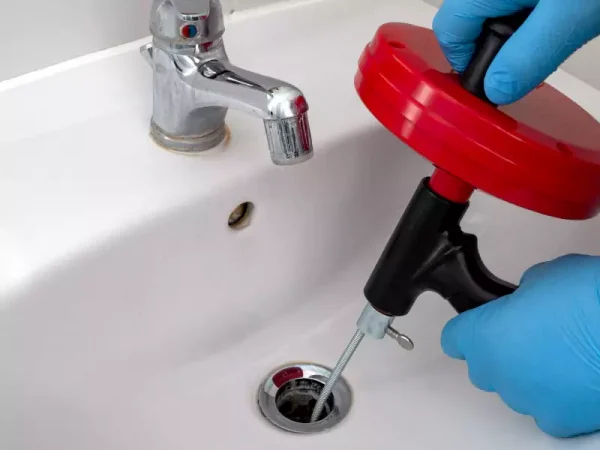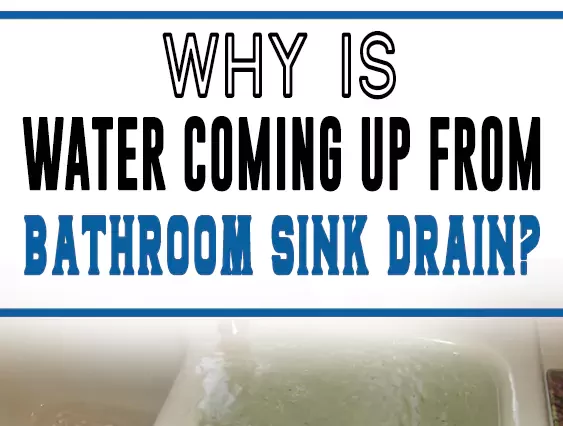Do you have a problem in the bathroom and need to know how to stop water from backing up bathroom sink? Here’s our complete guide to solving the problem.
If waste water comes up from the bathroom sink drain into your sink, this means that the drain is not functioning properly because it is clogged.
There might be some particles inside the sink drain which cause the water to be stuck and back up.
Another reason for water coming up a sink drain is an issue in the root system. Whatever the reason you need to stop the wastewater from backing up the bathroom sink.
Plumbing the bathroom sink drain accurately is important to drain properly. You can fix it with a plunger and hot water. I’m explaining why it causes and how to stop drain water from backing up a bathroom sink.

How to Stop Water from Backing Up Bathroom Sink
Method 1: Plunger

Use a plunger to help move whatever is stuck in your drain. This will solve the problem if the clog is just small. Fill in the sink with water. Make sure not to overfill as the water will splash once you’ve used the plunger.
Method 2: Drain Snake

Buy a drain snake and insert it inside your drain to unclog the block. This will help reach out to those particles which your plunger couldn’t reach.
Method 3: Hot water
Use hot water to melt down soap suds or bits of toothpaste that have hardened causing water to back up.
Method 4: Check the drain cover
The build of soap suds might be causing the clog, make sure to clean it properly. You can do a weekly clean-up of your drain cover to make sure nothing is accumulated. Build-up is prevented.
Method 5: Maintenance
Make sure that your pipes get a professional check-up at least once a year. This helps make sure that old pipes are removed and damaged once they are replaced
Method 6: Seek professional help
If the problem proves to be a major one, do not rely on the internet. Google may have all the information but a person with knowledge and experience is what you need to look for. This will fix the problem.
Method 7: Refrain from using chemicals
Boiling water, baking soda, and vinegar are not harmful and can be used. But do not use any other chemical in an attempt to unblock your drain.
You do not know its chemical composition. You might be putting yourself or the plumber at risk by using one.
Why Water Coming Back Up Bathroom Sink?
Food Particles
Your kids may enjoy munching on their snacks and some of these food particles get into the drain. The snacks could end up in the drainage and the build-up causes your bathroom sink drain to clog up.
Hair
For those who often brush their hair in the bathroom, fallen hair gets into the drain and eventually accumulates over time.
Fur
If you have plenty of pets around and especially when they are shedding, it’s not impossible that their fallen fur gets its way into the sink drain.
Toys
For those who have kids and like to give them toys while they brush their teeth in the pedestal sink or vessel sink, small particles of their toys could fall off and end up in your sink’s drain.
Toothpaste
Accumulated toothpaste bits could also be the culprit for why your sink drain is backing up. Make sure that your toothpaste gets into your toothbrush and not into your sink. Pour hot water into your sink to make sure that toothpaste build-up is avoided.
Multipurpose Pipes
This means that your bathroom pipe may be interconnected with other pipes in the house which are having issues and affects your bathroom sink.
Aging System
Your house might have had a plumbing line system for decades that needs maintenance and replacement.
Poor drainage can be caused by lines that haven’t been cleaned for years and accumulated blockage over time. If you bought an old house, it’s likely that your pipes are old and need some replacing.
Clogged Sink Trap
It is also known as the P-trap. This is an important plumbing component for sewer gas prevention but is also susceptible to clogging.
What to Do if Water Coming Up from Neighbor’s Drain Pipe
If your neighbor is using their dishwasher and suddenly you see brown dirty water coming from your sink drain, you have some serious plumbing issues in your unit.
This has to be fixed instantly. Otherwise, you will just end up getting dirty water coming up from the sink drain.
The best way to address this is to contact your contractor if you live in an apartment. If you own the house, seek a professional technician who understands the house’s blueprint and will identify the problem.
Your neighbor will also be more cooperative if there is a professional willing to help solve the issue. Tell them that the clogged pipe is your problem but could also be theirs if not resolved right away.
Could it Be Sewer Line Clogged?
If your bathroom sink keeps filling with wastewater and does not drain properly, most probably the sewer line is clogged. You may also notice that your bathtub is filled with dirty water.
Your sewer line may also be clogged whenever you flush the toilet, the water seems to drain very slowly.
How To Unclog the Main Sewer Line
If you are the do-it-yourself type of guy, you can follow these steps to help unclog your sewer line. Make sure that you wear the proper clothing and have safety gear, such as protective gloves and eye protector, when unclogging the sewer line.
Remember that you may want to save money from doing things yourself, but you could end up spending more if things get out of hand.
If you are unsure of what to do and if the main line is old, worn out, and damaged it is best to seek the help of a professional.
- Identify the cause of the clogging of your main sewer line. This could be tricky as you have several sources which need to be checked. You can start with the ones listed below
- A sink that often gets clogged by grease and oil
- Toilet bowl which is susceptible to fallen sanitary products
- Bathroom sink which accumulates soap and toothpaste
- Bathroom tub for fallen hair and other hygiene products
- Pour boiling water into the sink or make sure that hot water is running for at least 10 minutes. This will melt some of the materials which have solidified and could ease the blockage
- Switch off the main water valve of your house. Make sure that no water is running in the meantime and that you are fixing the blockage.
- Identify where your sewer clean-out is located. In most cases, you can find this underneath the house or in the garage area. Remove the cap so you could start cleaning it.
- Use a power washer with a jetter to clean out your sewer line. Make sure to take the proper precaution.
- Insert the jetter down the sewer line. Make sure to insert it as far as you can before using the trigger. You don’t want any wastewater on your skin. Start spraying.
- When done pull out the hose gently and clean it up with baking soda and vinegar.
Will Drano Unclog the Sewer Line?
Take note that the sewer line is the main line from your house which is responsible for transporting the wastewater from your household to the main line. It could be made from either a clay pipe, cast-iron pipe, Orangeburg, plastic sewer pipe, PVC pipe, or BAS pipe (The Spruce).
Pouring Drano into your sewer line will not unclog it but rather could harm your pipe.
The chemical content of this product could have a harmful reaction with the materials of your sewer line. Rather than using chemicals in your pipe, call a service technician to help troubleshoot the problem and fix it.
Do Toilets and Sinks Use the Same Drain?
Yes, they can share the same drain. However, since they both drain at the same time in some instances, the toilet pipe needs to be large enough to accommodate the water from the bathroom sink and the wastewater from the toilet bowl.
What happens if you use a small pipe? Chances are you will end up having a leaking pipe. The pressure from the water waste is just too strong for the pipe you are using.
In a worst-case scenario, the pipe would burst from water pressure. To avoid this from happening, make sure that you are using the right size for the pipe – a common valve within a 1.5m radius.
How to Prevent a Clogged Bathroom Sink
If you want to prevent your bathroom sink from filling up with water, make sure to follow these guide
- Pour hot water into the sink at least once a week. This is a preventive measure to avoid the products that you are using such as soaps, detergents, toothpaste, body lotion, and others from accumulating. If left unchecked, the product components harden up and could clog your pipe.
- Check for leaks – Any leaks in your bathroom could be an early sign of build up of unwanted materials into your pipe and could lead to a blocked bathroom sink
- Clean your drain cover – make sure to clean up your drain cover to prevent it from collecting hairs and other materials ending up in your pipe
- Check for large trees around your house – a clogged sink could be due to overgrown trees blocking up your pipe and sewer line
- Maintenance check – if you live in an old apartment/ house it is probable that the pipes are already old and worn out. Make sure that it gets checked to prevent the pipe from leaking/bursting or causing clogs. Pipes are susceptible to rust, especially the old ones, and need changing.
- Clean up after using the bathroom sink. If you see fallen hairs in the sink, pick them up and place them in the bin.
Key Takeaway
Clogged pipes are the result of accumulated debris that has been built up over time.
The first time you see water coming up the bathroom sink drain, it could be a sign of a blocked pipe.
Check immediately if there are any visible obstructions that you can remove right away. A plunger, boiling water or a drain snake are some quick ways to unclog the block.
I hope, now will be able to stop water from backing up the bathroom sink.

